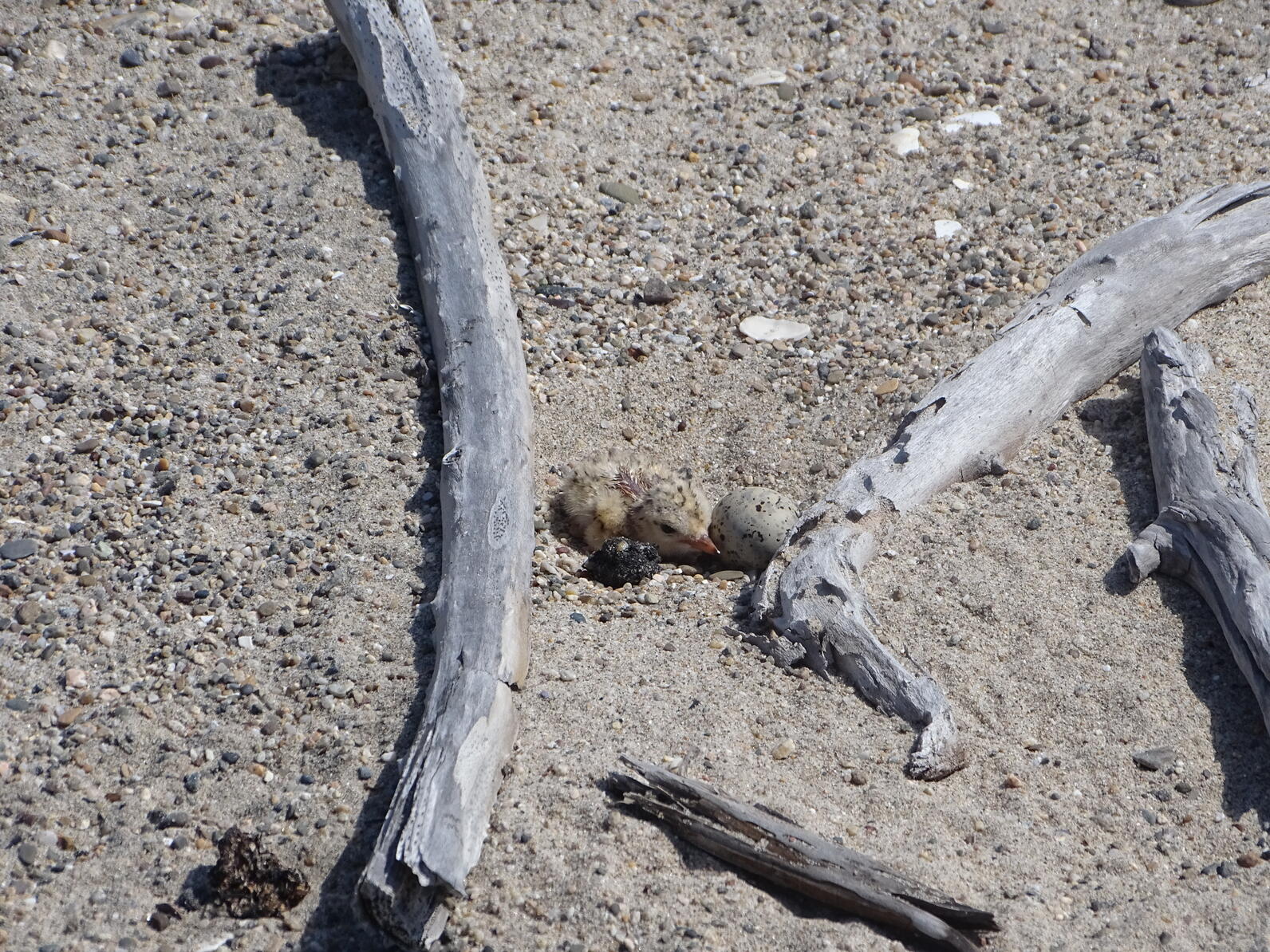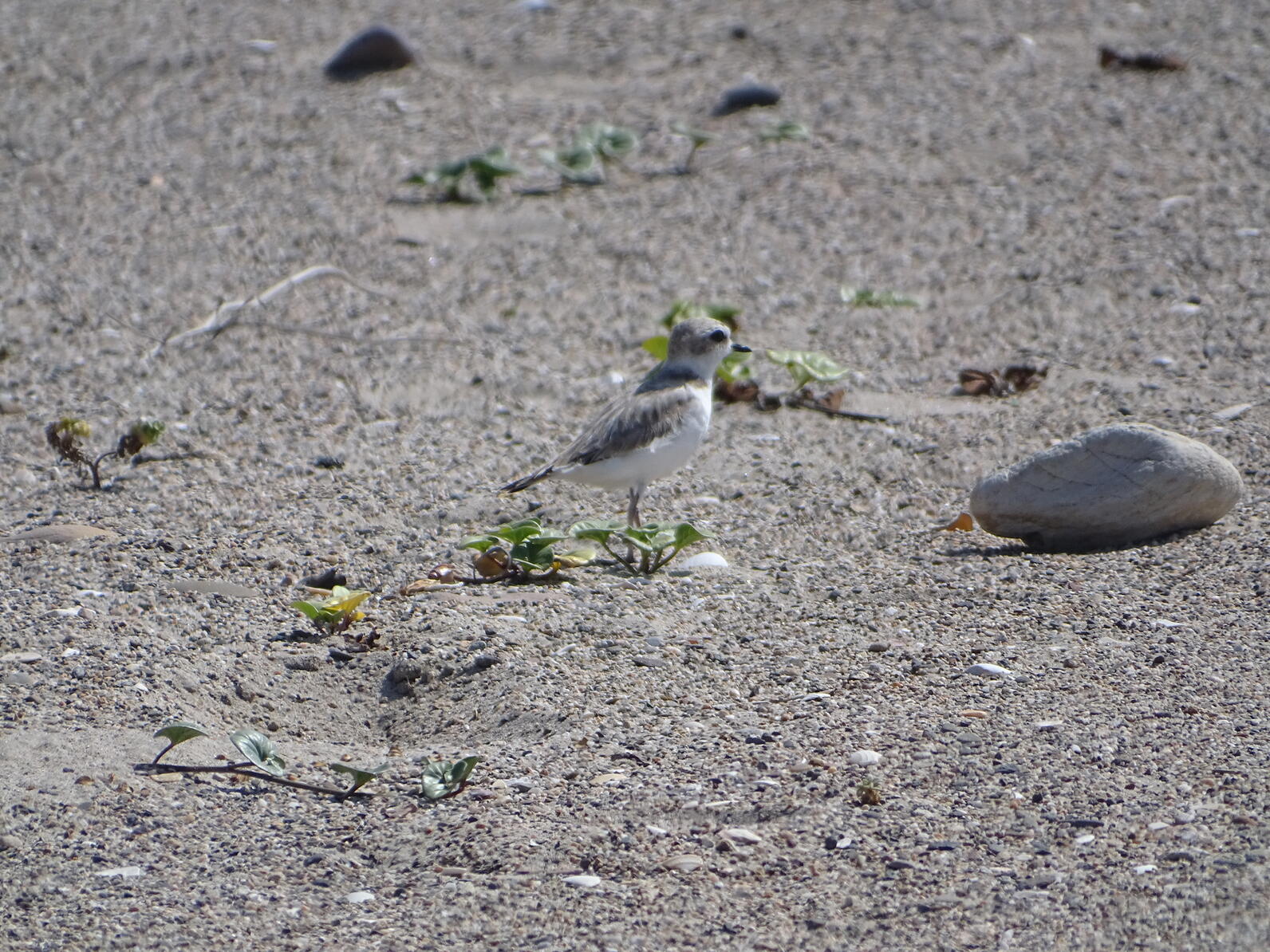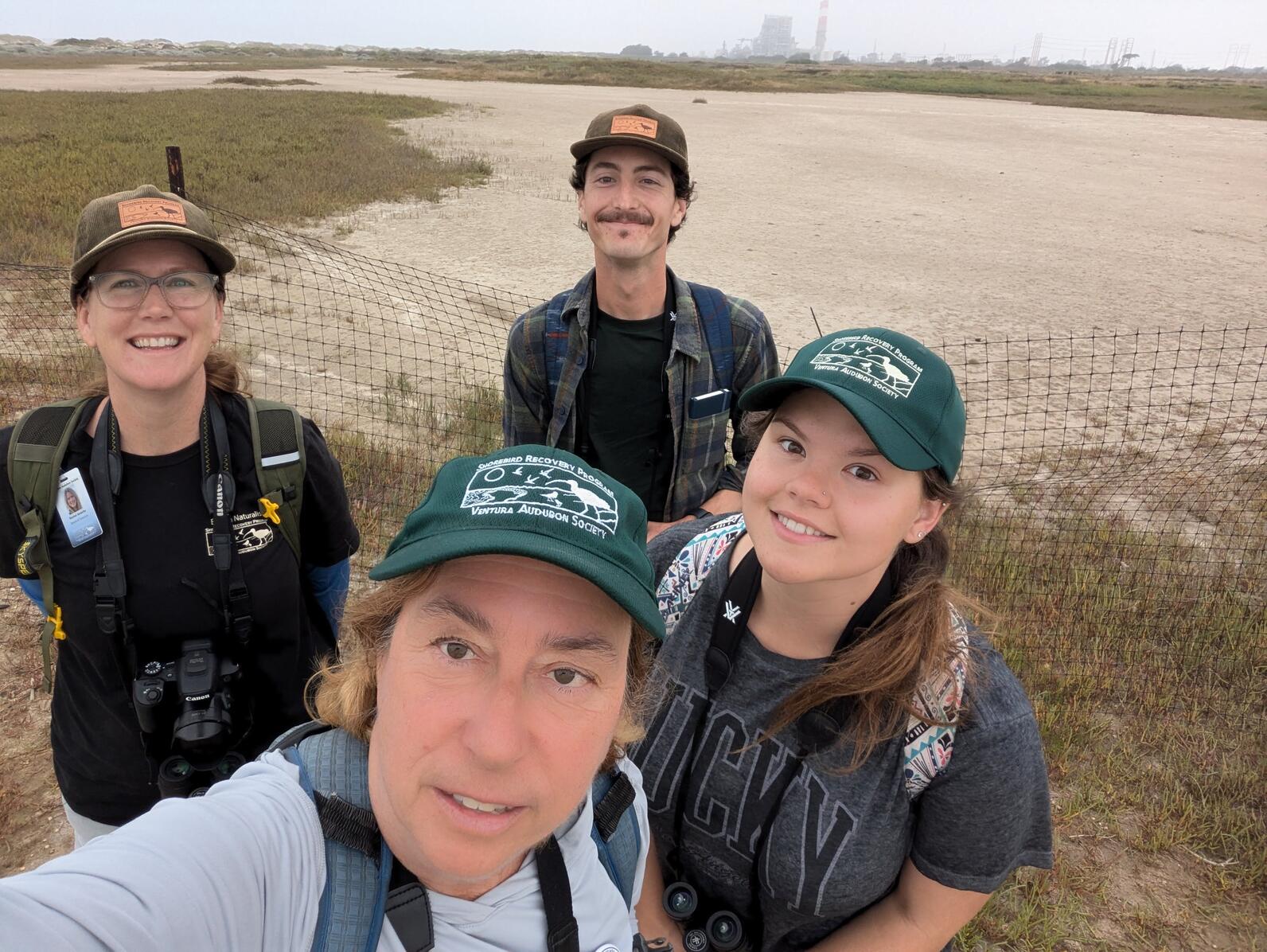Spending the morning on the beach admiring shorebirds is a beautiful way to start the day. I feel so at peace watching them forage along the tideline. The Willets, Long-billed Curlews, and even the wave-chasing Sanderlings are easy to spot. But if you look closely, you might catch a glimpse of a tiny, sandy brown and white blur scurrying across the sand—the Western Snowy Plover. These little birds blend in so well with their surroundings that spotting one can be a real challenge.
A Sneaky Shorebird
My first day on the job was learning all about Western Snowy Plovers and California Least Terns. I hadn’t spent much time observing these birds until I started working for Ventura Audubon’s Shorebird Recovery Program. After looking at images of the adorable Western Snowy Plovers, I thought they would be easy to spot on the beach. I was wrong. Trying to find a sand-colored bird on a vast beach expanse proved difficult (shocking, I know). After a few Saturday mornings scouring the Ormond Beach tideline for these fluffy little birds, I started to get the hang of it. Once I demonstrated my spotting skills, I was given the opportunity to enter the nesting area under the supervision of skilled and permitted biologists Cynthia Hartley and Kat Whitehouse to look for new nests. Nesting surveys became a part of my weekly routine, and I learned more every time. I developed a sense of the life of these birds and how they survive. The fact that they match the color of the sand is no coincidence. Camouflage is their best defense—from plumage to behavior to the appearance of their eggs.

Seeing these small shorebirds that only weigh about as much as 2 slices of bread race across an extensive stretch of beach made me realize they need all the help they can get. They are a threatened species, a designation under the Endangered Species Act because their population is in decline as a result of habitat loss and disturbance. This status means they could become endangered in the near future. There are already many obstacles to their survival: running across the sand searching for food, trying to lure predators away from their nests, protecting chicks once they hatch, and claiming territory against other Snowy Plovers…the list goes on and on. This only covers day-to-day survival in nature, not how humans impact these birds. Human disturbance, the presence of dogs, and trash on the beach all play a large role in a Snowy Plover’s survival, especially on popular beaches. Humans and dogs can startle birds off their nests, forcing birds to expend precious energy they should be using to forage or care for their chicks. And, as climate change worsens, sea level rise and severe weather pose a threat to Snowy Plover habitat. In 2019, a king tide event combined with high waves destroyed multiple Snowy Plover nests at Coal Oil Point. Fortunately, some eggs were recovered and brought to Santa Barbara Zoo’s Snowy Plover rearing facility where 13 out of 14 rescued eggs hatched. This isn’t a one-time occurrence. Ventura Audubon’s Shorebird Recovery team lost a nest during the 2023 king tide event. The washout went far into the Snowy Plover nesting area, but the other documented nests in that zone had already hatched. While it may sound like there is no hope for the Western Snowy Plovers, there is some good news. We still have a chance to act and protect our precious wildlife.

Action Against Climate Change
Taking action is the best thing we can do for wildlife. Some of it we can do by ourselves by making careful choices about where we shop, donating or volunteering with conservation organizations, and making sustainable choices in our everyday lives. The other significant player in protecting our environment is policy. Policy has a huge influence on the environment because regulations and mitigation efforts are put in place to promote water quality, habitat restoration, habitat protection, and access to green space. California voters have an opportunity to act on these issues by supporting Proposition 4, the Climate Bond, in November. This groundbreaking bond doesn’t just help wildlife—it will have monumental benefits for humans too.
Californians are no stranger to the impacts of climate change. We have faced the devastating impacts of wildfires, extreme heat, and drought across the state, and our coastal communities live under the threat of rising sea levels. These are only a few threats Californians face as climate change worsens. But, if Proposition 4 succeeds in November it will provide project funding for access to safe drinking water, air quality, reducing wildfire risks, extreme heat mitigation, sustainable agriculture, coastal resilience, and so much more. All these issues are important to tackle, and coastal resiliency is one that hits close to home.

Saving Our Coast
One of the many beauties of California is our extensive coastline. Across thousands of miles people, animals, and plants thrive on our coast. People recreate on the beaches and have established lives for themselves in nearby communities. Plants take root in the sand and provide habitat and nourishment to our pollinators. And birds—like our Western Snowy Plover friends—migrate across North America to nest on our beaches. Sea level rise threatens these natural wonders. With over half the state’s coastal habitat at risk of sea level rise, we must act now.
With proper funding from the Climate Bond, action can be taken to build coastal resiliency and protect this natural treasure for all Californians. Audubon and partner organizations like the Nature Conservancy and the California Coastal Conservancy have already developed a strategic approach to build coastal resiliency. Using nature-based solutions that restore the ecosystems of our beaches, such as the Sonoma Creek Enhancement Project, we strengthen the coast against flooding, sea level rise, and severe storms while improving the habitat for local wildlife. The natural ways to safeguard the coastline will look a little different depending on the environment and needs of the area. Let’s use Ormond Beach—a Snowy Plover nesting site—as an example.
The terrain of Ormond Beach has fluctuated over the years. It has always been known for its dunes and wetlands, but they aren't what they once were. Over the past 20 years, Ventura Audubon has done habitat protection work through the Shorebird Recovery Program, Beach Naturalist Program, and Conservation Committee. It’s their dedication that has allowed the dunes to slowly rebuild after being flattened by off-roading. Re-building the dune system on Ormond Beach by continuing habitat protection efforts and adding native plants with strong root systems that stabilize the sand is a nature-based way to strengthen the coastline by this beach. It could provide a barrier against flooding and severe storms to protect the communities, industry, and agricultural fields in the surrounding area. Additionally, the threatened Snowy Plover will have improved nesting grounds because they thrive in dune ecosystems. The benefits of habitat restoration in the area extend far beyond this species, and applying strategies like this across the California coast will have monumental benefits for all living things as we tackle climate change.
It’s time to take action for California’s future, and it starts with your vote on Proposition 4. This bond is an investment in our future that will help us protect and preserve the lives of humans, plants, and animals for generations to come. Our actions today will determine if future generations get to experience the same joy of seeing remarkable shorebirds like the Western Snowy Plover thrive in their natural habitat.
Resources
California legislature passes generational climate and education bonds. Official Website - Assemblymember Damon Connolly. (2024, July 4).
Callender, J. (2022, April 25). The Carpinteria Snowy Plovers: An Illustrated Timeline, 2019–2021. Carpinteria Birdwatchers.
Fernandez, P. (2020, October 28). Restoring Sonoma Creek for Climate Resilience. Audubon California.
Grannis, J. (2021, April 27). Putting Wetlands to Work for Disaster Recovery. Audubon.
Ormond Beach Restoration and Public Access Project Plan. City of Oxnard. (2021, May).
Restoration and Nature-Based Solutions. NCCOS Coastal Science Website. (2023, March 28).
SB-867 Safe Drinking Water, Wildfire Prevention, Drought Preparedness, and Clean Air Bond Act of 2024. California Legislative Information. (2024, July 5).
Secaira, M. (2024, July 23). A look at the $10B climate bond California voters will decide on in November. CapRadio.
Study finds climate change to blame for record-breaking California wildfires: August 8, 2023. Drought.gov. (2023, August 8).
Using nature to protect California’s iconic Coast. The Nature Conservancy. (2018, October 17).






